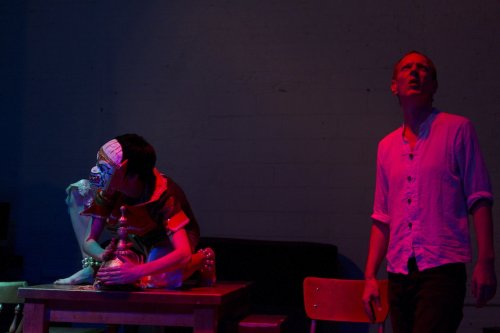In Alvin Lucier’s Queen of the South, performed here by the ensembles loadbang and Pygmy Jerboa, a metal plate is put into motion by amplified voices, such that sand on the plate forms into beautiful designs. Tom Johnson wrote, “[Lucier’s] own strongest association is with alchemy and that The Queen of the South is an alchemical term…He was attracted to the idea because of an appreciation for basic substances and for the mystery of how they interact with one another.”
On Structure is a sound-centric performance duo featuring Jessie Marino and Natacha Diels. The
New York based ensemble uses improvised and composed
Sounds {and the fluctuation of these sounds} to brew
Transferable art pieces which may
Ravage the realms of the performer, audience or space itself.
Uncovering the hidden motions of sound, freeing
Compositions from the fluorescence of the concert expectation.
Topsy-turvy.
Use of lasers, wigs, electronics, cellosandflutes;
Repurposing life experiences for music glitches and muscle twitches.
Eclipse boundaries of the stage.
Queen of the South
"lattices, networks, labyrinths, flows, currents, rotations, bridges, streams, beams, heaps, eddies, dunes, honeycombs, imbrications, cells, textures, turbulences, vortices, layers, figure-eights, lemniscates, spirals, rings, rivulets, trees…"
The above is a non-exhaustive list of the possible visual images to be created through sound and image by loadbang (Alejandro Acierto, Jeffrey Gavett, Andy Kozar, William Lang), Pygmy Jerboa (Ivan Naranjo, Maria Stankova) and Zach Layton (video), as they join forces for a performance of Alvin Lucier's "The Queen of the South" (1972), an exploration of the visual manifestation of sound. The amplified and transformed sound of instruments voices and electronics will be played through drivers attached to flat responsive surfaces like metal plates, on which "materials suitable for making visible the effects of sound" will be strewn.
Lucier's classic text score designates neither the sonic materials nor the form of the piece, but instead their visual results as created by fluids or sand vibrated by plates. All of the musical decisions being made are for the purpose of making visual images and patterns via the vibrations in the strewn materials, which are filmed in fixed close-up positions so that the audience and players may see them.
In "Strange Song Cycle" ON Structure (Jessie Marino and Natacha Diels) is joined by vocalist/composers Kate Soper (Wet Ink) and Maria Stankova (Pygmy Jerboa) for an hour long cycle of spectacles and song. These works question the use of language as an effective means of communication and refurbishes traditional song forms, by scrambling words with noise, light, shadow, objects, and implied motion. Works by Natacha Diels, Kate Soper and Maria Stankova.


